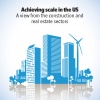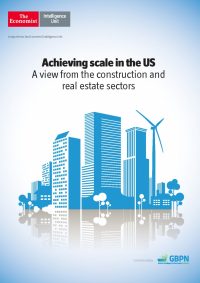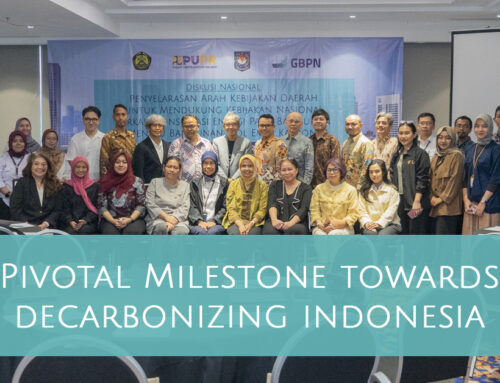[Report] Energy Efficiency Efforts in U.S. Buildings Should Focus on Improvements in Regulation and Financing
New Case Study Paper By the Economist Intelligence Unit and the Global Buildings Performance Network Identifies Key Strategies for Scaling Up Efficiency in US Buildings.
In the United States, buildings account for 41% of primary energy consumption, more than the transport or industrial sectors. Tackling rising energy consumption in U.S. buildings will require a more coordinated and coherent approach to energy efficiency codes and regulation, one that is more focused on retrofits—where most potential gains lie. It is also crucial to develop new financing mechanisms that help institutional investors assess the risks associated with energy-efficient projects.
These are the key findings from an Economist Intelligence Unit report, Achieving scale in the US: A view from the construction and real estate sectors, commissioned by the Global Buildings Performance Network (GBPN) in collaboration with its U.S. Hub, the Institute for Market Transformation (IMT) and in partnership with the World Business Council for Sustainable Development (WBCSD).
Other findings include:
- Energy efficiency regulation in the U.S. is patchy, confusing, and inconsistent. Building codes and other policies are too focused on new builds and often differ between states—and sometimes within them. As a result, the majority of U.S. companies manage energy efficiency at the building level rather than at the portfolio level.
- Innovative financing offers opportunities to achieve greater scale. Aggregating projects across and within sectors through green banks and large mortgage financing organizations allows for a more efficient allocation of capital and would likely attract large institutional investors.
- Both the public and the private sectors must work to address the data challenge. Data on energy efficiency performance is limited, unshared, and often inconsistent between measurements. Institutional investors require standardized data on the energy and financial performance of projects.
- Co-benefits of energy efficiency retrofits include higher occupancy rates and higher tenant retention. While many of these co-benefits like reduced carbon emissions have yet to be priced into the market, some—for example, greater comfort—are almost immediately tangible for both companies and their customers.
Analysis from experts of the GBPN network – Watch the video:
This Case Study report about the U.S. is a follow-up to the EIU global report published last October, Energy efficiency and energy savings – a view from the building sector that showed that US business leaders in Real Estate and Construction are less likely to accept reducing CO2 emissions associated with their business as a core responsibility. The survey found 60% of U.S. survey respondents consider climate change a core business responsibility while more than 80% are of that opinion in Europe, China, and India. While a majority of U.S. business leaders are implementing efficiency measures in their buildings, to encourage greater investments, they urge policy makers to provide more consistent and ambitious policy direction.
Joint GBPN and Johnson Controls’ Institute for Building Efficiency (IBE) Roundtable dialogue in Washington:
GBPN’s Jayson Antonoff unveiled the highlights of the report Achieving scale in the US: A view from the construction and real estate sectors on June 12 at a roundtable dialogue in Washington, “Insights, Indicators and Interest in Achieving Scale With Energy Efficiency in the United States” hosted with Johnson Controls’ Institute for Building Efficiency (IBE). The event brought together leaders from the public and private sectors to discuss trends in the energy efficiency market. A wide-ranging conversation focused on: the importance of energy benchmarking and disclosure to drive market transformation; the need for analysis and standardization as well as collection of building energy data; the value of co-benefits of efficiency; and whether lack of financing is as significant a barrier as many people assume.
Other formats of this report:
- Highlights
- Briefing
- Multimedia: Analysis from the GBPN network – Watch the video
Also consult the October global report:
- Energy Efficiency and Energy Savings: A View from the Building Sector, October 2012
- Highlights
- Briefing
- Multimedia
This report is part of a series of case study reports by the EIU commissioned by the GBPN in collaboration with its Regional Hubs and Partners about invvesting in energy efficiency in buildings in China, Europe, India and the U.S. (Our Network).
Related News
- [Report] Are Businesses Ready to Go Deep in Energy Efficiency?
- [Report] Achieving Scale With Energy Efficiency in the U.S.: New Video
Related Report Bundles
- Achieving Scale in Energy-efficient Buildings in US: A View from the Construction and Real Estate Sectors
- 从建筑业和地产业视角看美国实现节能建筑规模化
Related Laboratory Projects
Share This Story, Choose Your Platform!
Stay in touch with how we’re transforming the buildings sector
GBPN runs innovative building policy reform programs in key regions around the world that aim to tackle the climate emergency by decarbonising the buildings sector. Stay up to date with our newsletter.
Stay in touch with how we’re transforming the buildings sector
GBPN runs innovative building policy reform programs in key regions around the world that aim to tackle the climate emergency by decarbonising the buildings sector. Stay up to date with our newsletter.








